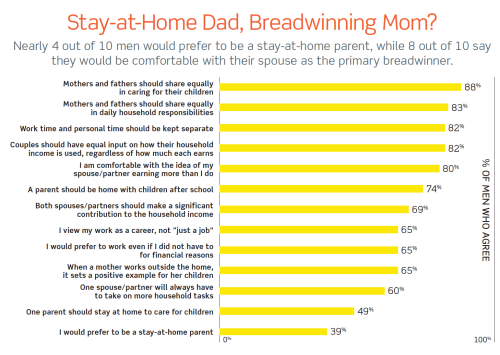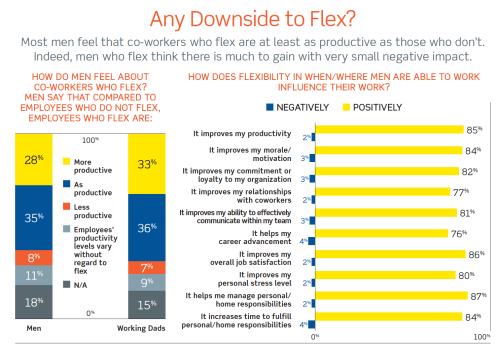The Working Mother Research Institute (WMRI), in partnership with Ernst & Young, recently released a report aimed at better understanding “how men are navigating the flexible work and home terrain.” Data from How Men Flex, The Working Mother Report is the result of survey responses from 2,000 men and women (evenly split) with questions aimed at understanding the impact of flexible work arrangements on their lives. While the impression may be that flexible work arrangements are greater utilized by female employees, WMRI’s data indicates that flexibility in the work environment is both used and desired by men and women equally. 77% of men report having flexible schedules and 79% state that they feel comfortable using such flexibility. Additionally, 62% of men state that their employers can and do support flexible scheduling. What’s also clear from WMRI’s data is that working mothers aren’t the only people struggling to with balancing work and family. 26% of men report that their employers could encourage flexible scheduling but don’t. WMRI notes that in recent studies both working mothers and working fathers, have almost equally agreed that they feel stressed about meeting their responsibilities in both their work and home environments. Studies have also shown that men are increasingly involved in the balancing act of family and work, something that’s often seen exclusively as a working mother’s issue. WMRI highlights a 2011 report, which showed that fathers spent 7 hours a week on childcare and 10 hours a week on housework, a significant increase from a 1965 study that reported fathers spent 2.5 hours a week on childcare and 4 hours on house work.
The above graph highlights changing perceptions when it comes to work and family; 88% of men report that mothers and fathers should share equally in caring for their children and 83% report that household work should be shared equally as well. Organizations should make sure there is an inclusive focus on flexible scheduling not only because family management is a shared responsibility but also because flexible scheduling benefits employers in several ways. The data show that men with access to flexible scheduling are more likely to say they are happy, productive, have high have morale, good relationships with co-workers, and are overall more satisfied with their job than men without access to flexible scheduling.
Employers who do not provide flexible scheduling lose a valuable tool for attracting talent and could be increasing their risk of losing valuable talent they do have. Right out the door, 54% of working fathers and 47% of men without kids state that they would reject a job with frequent travel due to obligations at home.
What flex options should employers provide? While that depends largely on each organization’s professional needs (and their employees’ personal needs) men surveyed for WMRI’s report state that two days of telecommuting each week work best for them. These respondents report higher levels of satisfaction on almost all fronts compared to those who never work from home. Men who commute two days a week also report higher levels of satisfaction than those who work from home three to five days a week.
WMRI’s report also finds that 6 in 10 working dads would work part-time if they could still enjoy a satisfying career; however, 36% of working dads say part-time work is looked down upon at their organizations. Working fathers, like working mothers, also report difficulty in managing boundaries around work, with 46% reporting that their job bleeds into their personal time, compared to 32% of men without children.
The data here suggest that flexible scheduling options are just as valuable for men as they are for women, and, moreover, are an area that many organizations are unintentionally neglecting to make as accessible to male employees. Organizations should make sure to engage all employees in conversations around flex time, and to publicize that flex programs are available and their use is encouraged by all.















